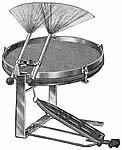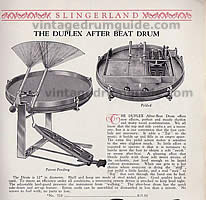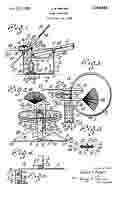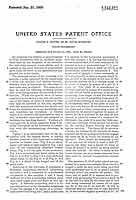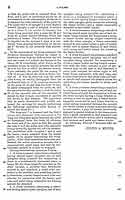|
Duplex
After-Beat
Drum
Is Announced perfect and steady rhythm and many novel combinations.
The monotonous 'clank' of foot cymbals has been eliminated. It's
all that you would want it to be.
"The
extra-fine pedal action makes it sensitive to the very slightest
touch. So little effort is required to operate it that it is necessary
to barely move the foot to obtain a soft 'swish' or 'sweep' after-beat.
"Can
also be played on the beat, eliminating bass drum altogether,
if desired. "No practice is necessary to operate it, if you
can play a Charleston pedal, and most modern drummers can do that."
The new After-Beat drum is twelve inches in diameter with shell
and hoop made of nickelplated steel and good quality head, heel
guard, patent brush holder to accommodate two brushes, quick take-down
and compact folding. It will retail for $15.
Latest
Addition to Line of Duplex Mfg. Co., St. Louis, Is Announced to
the Retail Trade ST. LOUIS, MO., March 5.—The new Duplex
After-Beat drum was announced this week to the music trade in
an eight-page two-color advertising broadside sent to the trade
by the Duplex Mfg. Co., maker of Duplex drums and drum products,
2815 Henrietta street. It is a unique instrument that is expected
to be greatly in demand by orchestra drummers. It offers an unlimited
variety of syncopated and rhythmical effects heretofore unknown
in dance drumming.
The After-Beat drum is the creation of J. A. Meyer, head of the
company, and he tells the story of it in the circular. Here are
his words: "Ever since the advent of making use of the left
foot for after-beat rhythm it has been put to only one use—that
of playing cymbals. The idea of playing after-beats with the foot
is indeed a very good one, but playing it with cymbals has not
proven practical owing to the fact that there are only certain
passages where foot cymbals can be used with good effect. It is
our opinion, and many of the profession have agreed with us on
this point, that After-Beat Rhythm should be maintained constantly
throughout the number. If the drummer is obliged to stop using
his foot cymbals, and this has been the case, he immediately takes
something from the rhythm that should be there.
"Another
objection to the old method has been too much cymbals. Cymbals
on top of the drum, side cymbal and foot cymbals. No variety at
all. We all know that top and side cymbals are a necessity, but
it is our contention that foot cymbals are superfluous. "With
the 'Duplex' After-Beat Drum comes a new era in dance drumming.
New effects.
Here
is the patent filed Jan 21, 1928 and issued Jan 21, 1930
|

